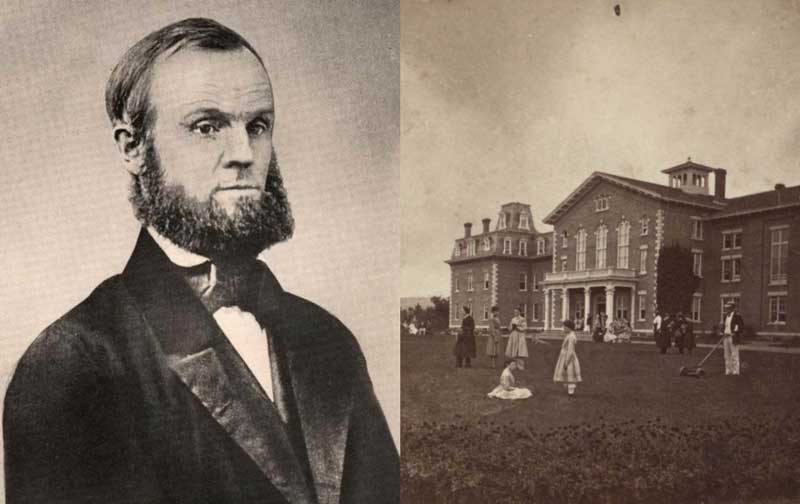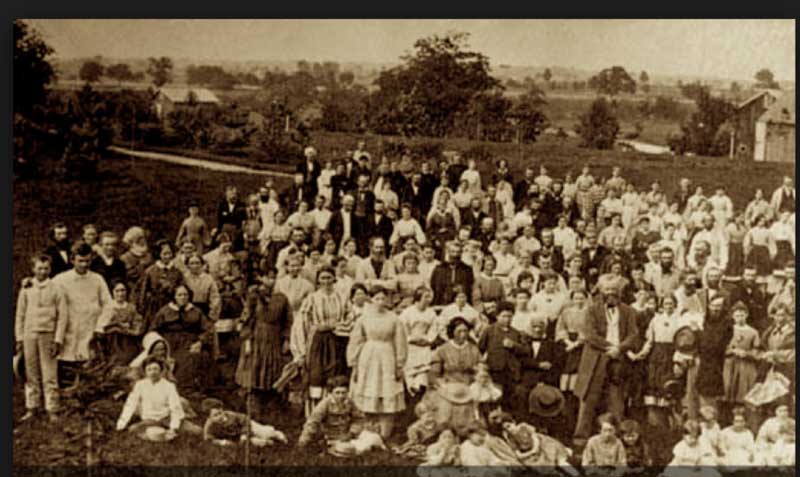
In the first part of the 19th century, in the late 1840s, a group of people, under the leadership of the reputedly charismatic John Humphrey Noyes, founded the Oneida Community in Oneida, New York. It was a Perfectionist religious communal society and the members of the society dedicated themselves to live as one family and to share all their property, work and love. They believed that the Kingdom of God on Earth had arrived with the second coming of Jesus during the destruction of the temple in Jerusalem in 70 AD and they embraced the communalism of the early Christian Church in their effort to create an equal and rational society in their new Eden.
John Humphrey Noyes, who studied theology at Yale, was forced out and refused a license to preach because of his controversial ideas. Noyes believed that Socialism without religion was impossible and only the extended family system can dissolve selfishness and demonstrate the practicality of perfectionism on Earth. He was convinced that monogamy is selfish and all men were to be married to all women in the community. His aim was to create a religious utopia where members challenged the societal norms of the time regarding gender and social status. Its residents practiced communalism and complex marriage, which can be termed as a form of polyamory, the practice of engaging in multiple sexual relationships with the consent of all the people involved. However, the intimate closeness between a particular man and a woman was strongly forbidden and in such case the couple would invariably be separated, as it would end up in selfishness, the primordial sin.

The members of the Oneida Community used to live in a shared home, which they called the Mansion House, built in 1848. At its height, nearly 300 people lived in the 93000-square-feet home, where members lived as one family, sharing romantic partners and responsibility for all the children born in the community.
The Community believed and practiced communalism, in the sense of communal property, communal possessions and complex marriage. They strongly believed in a system of free love, which they called complex marriage, where any member was free to have sex with any other who consented. Noyes believed that complex marriage would move the community beyond divisive commitments to a single partner or family. All the men were thought to be linked in divine marriage to all the women, possessiveness and exclusive relationships were prohibited. The community practiced coitus reservatus or male continence, in other words, intercourse without ejaculation, which can be explained as a form of sexual intercourse in which the penetrative partner does not ejaculate within the receptive partner, instead attempts to remain at the plateau phase of intercourse for as long as possible.

Children were raised communally and did not live with their parents. The adolescents were often introduced to their sexuality by the older members of the community. While older men often introduced young women to sex, women over the age of 40 used to act as sexual mentors to the adolescent boys, as these relationships had minimal chance of conceiving. Noyes often used his own judgment in determining the partnerships that would form and he was often the first to have sex with the girls, as soon as they reached puberty.
To support the commune financially, the members founded a manufacturing company and used to sell some metal product like, cutlery, canning supplies and silk. When the community finally dissolved in 1881, the cutlery side of the manufacturing business eventually survived to become the globally known silverware company Oneida Limited.

The Oneida Community began to decline by 1870, as Noyes tried to pass the leadership to his son, Theodore Noyes, who lacked the charisma and leadership quality of his father. The move also divided the community, as John Towner attempted to take control of the community. Apart from that, many members of the younger generation desired to discontinue the complex marriage and to enter into the traditional exclusive marriages. In the meantime, John Humphrey Noyes was informed by his trusted adviser Myron Kinsley that a warrant for his arrest on charges of statutory rape was imminent. The information shook the base of the Oneida Community and as Noyes fled to Canada in late June 1879, never to return to the United States again, the community soon abandoned complex marriage and broke apart.

Nevertheless, today the Oneida Limited, founded in 1880, is considered as the largest supplier of dinnerware to the food service industry in North America and one of the largest flatware manufacturers in the world. The commune’s Mansion House has been designated a National Historic Landmark, surrounded by 33 acres of landscaped lawns, gardens and a historic golf course. The last original member of the Oneida Community, Ella Florence Underwood died on 25 June 1950, at the age of 101, in Kenwood, New York near Oneida.